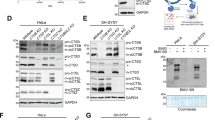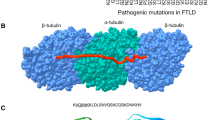Abstract
The aetiological agent of prion disease is proposed to be an aberrant isoform of the cell surface glycoprotein known as the prion protein (PrPc). This pathological isoform (PrPSc) is abnormally deposited in the extracellular space of diseased CNS. Neurodegeneration in these disease has been shown to be associated with accumulation of PrPSc in affected tissue. To investigate the possible uptake mechanisms that may be required for PrPSc-induced neurodegeneration we studied the cellular trafficking of the neurotoxic fragment, PrP106-126. We were able to detect, by fluorescence microscopy, PrP106-126 inclusions in murine neurones, astrocytes and microglia in vitro. These inclusions were abundant after 24 hour exposure and still present 48h post-exposure. Shorter exposure times yielded only occasional cells with inclusions. Large extracellular aggregates of PrP106-126 could also be detected, which appeared in a time dependent manner. The appearance of inclusions or aggregates was not dependent on PrPc expression as determined by exposure of peptides from PrP-null mice. Using transmission electron microscopy and gold particle detection, positively labelled osmiophilic inclusions of peptide could be detected in the cytoplasm of exposed cells. These results demonstrate that cultured cells are capable of sequestering PrP106-126 and may indicate uptake pathways for PrPSc in various cell types. Toxicity of PrP106-126 may thus be mediated via a sequestration pathway that is not effective for this peptide in PrP-null cells.
Similar content being viewed by others
References
ARNOLD, J. E., TIPLER, C., LASZLO, L., HOPE, J., LANDON, M. & MAYER, R. J. (1995). The abnormal isoform of the prion protein accumulates in late-endosome-like organelles in scrapie-infected mouse brain. Journal of Pathology 176, 403–11.
BORCHELT, D. R., TARABOULOS, A. & PRUSINER, S. B. (1992) Evidence for synthesis of scrapie prion proteins in the endocytic pathway. Journal of Biological Chemistry 267, 16188–199.
BRANDNER, S., ISENMANN, S., RAEBER, A., FISCHER, M., SAILER, A., KOBAYASHI, Y., MARINO, S., WEISSMANN, C. & AGUZZI, A. (1996) Normal host prion protein necessary for scrapie-induced neurotoxity. Nature 379, 339–43.
BROWN, D. R., HERMS, J. & KRETZSCHMAR, H. A. (1994) Mouse cortical cells lacking cellular PrP survive in culture with a neurotoxic PrP fragment. NeuroReport 5, 2057–60.
BROWN, D. R., SCHMIDT, B. & KRETZSCHMAR, H. A. (1996a) Role of microglia and host prion protein in neurotoxicity of prion protein fragment. Nature 380, 345–47.
BROWN, D. R., SCHMIDT, B. AND KRETZSCHMAR, H. A. (1996b) A neurotoxic prion protein fragment enhances proliferation of microglia but not astrocytes in culture. Glia 18, 59–67.
BROWN, D. R., QIN, K., HERMS, J. W., MADLUNG, MANSON, J., STROME, R., FRASER, P. E., KRUCK, T., A., VON BOHLEN, A., SCHULZSCHAEFFER, W., GIESE, A., WESTAWAY, D. & KRETZSCHMAR, H. A. (1997a) The cellular prion protein binds copper in vivo. Nature 390, 684–87.
BROWN, D. R., SCHULZ-SCHAEFFER, W. J., SCHMIDT, B. & KRETZSCHMAR, H. A. (1997b) Prion protein-deficient cells show altered response to oxidative stress due to decreased SOD-1 activity. Experimental Neurology 146, 104–12.
BROWN, D. R., HERMS, J. W., SCHMIDT, B. & KRETZSCHMAR, H. A. (1997c) Different requirements for the neurotoxicity of fragments of PrP and bamyloid. European Journal of Neuroscience 9, 1162–69.
BROWN, D. R., SCHMIDT, B., GROSCHUP, M. H. & KRETZSCHMAR, H.A. (1998a) Prion protein expression in muscle cells and toxicity of a prion protein fragment. European Journal of Cell Biology 75, 29–37.
BROWN, D. R., BESINGER, A., HERMS, J. W. & KRETZSCHMAR, H. A. (1998b) Microglial expression of the prion protein. NeuroReport 9, 1425–29.
BROWN, D. R., PITSCHKE, M., RIESNER, D. & KRETZSCHMAR, H. A. (1998c) Cellular effects of a neurotoxic prion protein peptide are related to its b-sheet content. Neuroscience Research Communications 23, 119–28.
BROWN, D. R., SCHMIDT, B. & KRETZSCHMAR, H. A. (1998d) A prion protein fragment interacts with PrPdeficient cells. Journal of Neuroscience Research 52, 260–67.
BROWN, D. R. (1998) Toxicity of a b-amyloid peptide fragment in neurones and glia with reduced APP expression. Alzheimer's Reports 1, 223–31.
BROWN, H. R., GOLLER, N. L., RUDELLI, R. D., MERZ, G. S., WOLFE, G. S., WISNIEWSKI, H. M & ROBAKIS, N. K. (1990). The mRNA encoding the scrapie agent is present in a variety of non-neuronal cells. Acta Neuropathologica 80, 1–6.
BÑELER, H., FISCHER, M., LANG, Y., BLUETHMANN, H., LIPP, H.-P., DEARMOND, S. J., PRUSINER, S. B., AGUET, M. & WEISSMANN, C. (1992) Normal development and behaviour of mice lacking the neuronal cell-surface PrP protein. Nature 356, 577–82.
BÑELER, H., AGUZZI, A., SAILER, A., GREINER, R.-A., P., A., AUGET, M. & WEISSMANN, C. (1993) Mice devoid of PrP are resistent to scrapie. Cell 73, 1339–47.
CASHMAN, N. R., LOERTSCHER, R., NALBANTOGLU, J., SHAW, I., KASCSAK, J., BOLTON, D. C. & BENDHEIM, P. E. (1990). Cellular isoforms of the scrapie agent protein participates in lymphocyte activation. Cell 61, 185–92.
CHIESA, R., ANGERETTI, N., LUCCA, E., SALMONA, M., TAGLIAVINI, F., BUGIANI, O. & FORLONI, G. (1996) Clusterin (SGP-2) induction in rat astroglial cells exposed to prion protein fragment 106-126. European Journal of Neuroscience 8, 589–97.
DIEDRICH, J. F., BENDHEIM, P. E., KIM, Y. S., CARP, R. I., & HAASE, A.T. (1991) Scrapie-associated prion protein accumulates in astrocytes during scrapie infection. Proceedings of the National Academy of Sciences USA 88, 375–79.
FORLONI, G., ANGERETTI, N., CHIESA, R., MONZANI, E., SALMONA, M., BUGIANI, O. & TAGLIAVINI, F. (1993) Neurotoxicity of a prion protein fragment. Nature 362, 543–46.
GIESE, A., BROWN, D. R., GROSCHUP, M. H., FELDMANN, C., HAIST, I. & KRETZSCHMAR, H. A. (1998) Role of microglia in neuronal cell death in prion disease. Brain Pathology 8, 449–57.
HERMS, J. W., MADLUNG, A., BROWN, D. R. & KRETZSCHMAR, H. A. (1997) Increase of intracellular free Ca21 in microglia activated by prion protein fragment. Glia 21, 253–57.
HOPE, J., SHEARMAN, M. S., BAXTER, H. C., CHONG, A., KELLY, S. M. & PRICE, N. C. (1996) Cytotoxicity of prion protein (PrP106–126) differs in mechanism from the cytotoxicity activity of the Alzheimer's disease amyloid peptide Ab25-35. Neurodegeneration 5, 1–11.
JEFFREY, M., GOODSIR, C. M., BRUCE, M. E. & MCBRIDE, P. A., SCOTT, J. R. & HALLIDAY, W. G. (1994). Correlative light and electron microscopy of PrP localization in 87v scrapie. Brain Research 656, 329–43.
JOHNSON, B. D. & BYERLY, L. (1993). A cytoskeletal mechanism for Ca21 channel metabolic dependence and inactivation by intracellular Ca21. Neuron 10, 797–804.
VAN KEULEN, L. J. M., SCHREUDER, B. E. C., MELOEN, R. H., POELEN-VAN DER BERG, M., MOOIJ-HARKES, G., VROMANS, M. E. W. & LANGEVALD, J. P. M. (1995) Immunohistochemical detection and localization of prion protein in brain tissue of sheep with natural scrapie. Veterinary Pathology 32, 299–308.
KRETZSCHMAR, H. A., PRUSINER, S. B., STOWRING, L. E. & DEARMOND, S. J. (1986) Scrapie prion proteins are synthesized in neurons. American Journal of Pathology 122, 1–5.
MANN, D. M. A., YATES, P. O. & MARCYNUIK, B. (1985) Some morphometric observations on the cerebral cortex and hippocampus in presenile Alzheimer's disease, senile dementia of Alzheimer type and Down's syndrome in middle age. Journal of Neurological Sciences 69, 139–59.
MANSON, J., WEST, D. J., THOMSON, V., MCBRIDE, P., KAUFMAN, M. H. & HOPE, J. (1992). The prion protein gene: Arole in mouse embryogenesis? Development 115, 117–22.
MARTINS, V. R., GRANER, E., GARCIA-ABREU, J., DE SOUZA, S. J., MERCADANTE, A. F., VEIGA, S. S., ZANATA, S. M., NETO, V. M. & BRENTANI, R. R. (1997) Complementary hydropathy identifies a cellular prion protein receptor. Nature Medicine 3, 1376–82.
MEYER, R. K., MCKINLEY, M. P., BOWMAN, K. A., BRAUNFELD, M. B., BARRY, R. A. & PRUSINER, S. B. (1986) Separation and properties of cellular and scrapie prion proteins. Proceedings of the National Academy of Sciences USA 83, 2310–14.
MOSER, M., COLELLO, R. J., POTT, U., & OESCH, B, (1995) Developmental expression of the prion protein gene in glial cells. Neuron 14, 509–17.
PRUSINER, S. B.M (1991) Molecular biology of prion disease. Science 252, 1515–22.
SALMONA, M., FORLONI, G., DIOMEDE, L., ALGERI, M., DEGIOLA, L., ANGERETTI, N., GIACCONE, G., TAGLIAVINI, F. & BUGIANI, O. (1997) A neurotoxic and gliotrophic fragment of the prion protein increases plasma membrane microviscosity. Neurobiology of Disease 4, 47–57.
SELVAGGINI, C., DE GIOIA, L., GHIBAUDI, E., DIOMEDE, L., PASSERINI, F., BUGIANI, O., TAGLIAVINI, F. & SALMONA, M. (1993). Molecular characteristics of a protease-resistant, amyloidogenic and neurotoxic peptide homologous to residues 106-126 of the prion protein. Biochemical and Biophysical Research Communications 194, 1380–86.
VEY, M., PILKUHN, S., WILLE, H., NIXON, R., DEARMOND, S. J., SMART, E. J., ANDERSON, R. G. W., TARABOULOS, A. & PRUSINER, S. B. (1996) Subcellular colocalization of the cellular and scrapie prion proteins in calveolae-like membranous domains. Proceedings of the National Academy of Sciences USA 93, 14945–49.
YANKER, B. A., DUFFY, L. K. & KIRSCHNER, D. A. (1990). Neurotrophic and neurotoxic effects of amyloid b protein: reversal by tachykinin neuropeptides. Science 25, 279–82.
Author information
Authors and Affiliations
Rights and permissions
About this article
Cite this article
Mchattie, S.J., Brown, D.R. & Bird, M.M. Cellular uptake of the prion protein fragment PrP106-126 in vitro. J Neurocytol 28, 149–159 (1999). https://doi.org/10.1023/A:1007028323666
Issue Date:
DOI: https://doi.org/10.1023/A:1007028323666




